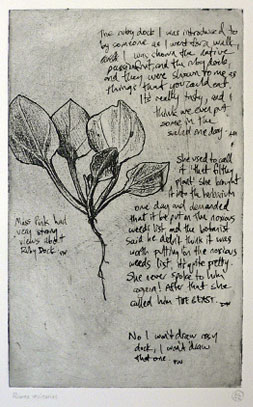 |
 |
| May 13 - June 9, 2007
Olive Pink Botanic Garden
Alice Springs, NT |
|
|  arly
last year we were invited to take part in Shifting
Ground, a curated program of site-specific, temporary
public artworks held in Alice Springs and featuring
artists from across Australia and overseas. arly
last year we were invited to take part in Shifting
Ground, a curated program of site-specific, temporary
public artworks held in Alice Springs and featuring
artists from across Australia and overseas.
For this event we spent three weeks working
as artists-in-residence at the Olive
Pink Botanic Garden, investigating the layered histories
of the site and its potential as a catalyst for dialogue
and exchange. The project culminated in a solo exhibition,
They talk of ‘disphorrea’, consisting
of a site-specific installation and collection of works
on paper: |
|
|
 |
They talk of ‘disphorrea’
(Erythrina vespertilio, Hakea
divaricata, Eremophila freelingii, Santalum acuminatum,
Capparis spinosa var. nummularia, Senna artemesiodes ssp
artemesiodes, Acacia aneura, Cenchrus ciliaris, Rumex vesicarius)
2007
25 solar etched intaglio prints
with hand-written text
Ink on paper
107 x 172mm
&
Site-specific installation
Re-used information board, trestle legs, fold-up chairs,
fold-up tables, light boxes, suitcase, printmaker’s
press, pinboards, books, pencils, paper, photographs, drawings,
solar etchings, plant specimens, found objects
Dimensions variable |
|
 |
 |
| View of exhibition showing works on paper |
|
 |
 |
| Opposite view of exhibition showing installation |
|
 |
|  he
work was structured around an informal study of eight different
plants found within the Garden, all of which held some significance
for the Garden’s historic founder, anthropologist
and amateur botanist Miss
Olive Pink. The lingering traces of this controversial
figure, who was socially ostracised for her passionate views
in support of Indigenous Australians and Central Australian
native flora, are a recurring motif within the work, linking
contemporary debates about the effects of colonisation with
critical voices of an earlier time. he
work was structured around an informal study of eight different
plants found within the Garden, all of which held some significance
for the Garden’s historic founder, anthropologist
and amateur botanist Miss
Olive Pink. The lingering traces of this controversial
figure, who was socially ostracised for her passionate views
in support of Indigenous Australians and Central Australian
native flora, are a recurring motif within the work, linking
contemporary debates about the effects of colonisation with
critical voices of an earlier time.
Our chosen plants formed the basis of
a series of conversations held with members of the local
community, and led to the production of a set of works on
paper involving botanical illustration, solar etching, and
hand-written excerpts of those conversations. The finished
works evoke a range of different understandings of and relationships
to place, and bring into public discourse the contestation
underlying how our natural environment is managed, valued
and storied.
|
 view
more prints
view
more prints |
|
 |
 |
Rumex
vesicarius
2007
solar etching and ink on paper
25 x 17 cm |
|
 |
 |
Capparis spinosa var.nummularia
2007
solar etching and ink on paper
25 x 17 cm |
|
 |
|
 |
|
 |
|
 |
|
 |
|
 |
| A note on the title
The title of this work comes from a letter
written in 1932 by Olive Pink to a friend, in which she
calls for her colleagues to take a more honest and pragmatic
look at the situation of Aboriginal Australians. ‘Disphorrea’
was a pseudo-scientific term popular at the time, used to
describe the phenomenon of a tribe’s loss of ‘its
sense of self’, to which anthropologists were attributing
many of the hardships experienced by Indigenous people.
In this letter, Miss Pink claims that such abstract justifications
naturalised the violence of the colonisation process in
Australia, masking the real causes of Aboriginal disadvantage
such as alcohol, venereal disease, and abuse by white settlers.
Such determination to bring into public discourse the realities
of colonisation and the ongoing contestation of land in
this country was a point of inspiration throughout the making
of this work. |
|
|
 |
| Thank yous
We must acknowledge the invaluable support
and assistance we received from everyone in Alice Springs:
Kieren Sanderson of Shifting Ground, Art Land Culture and
Watch This Space gallery for the opportunity to participate
in such a unique event; Colleen O’Malley and Alex
Nelson at the Olive Pink Botanic Garden, without whom this
work would have been impossible; all the participants who
generously gave of their time and knowledge to talk with
us about plants; Steve Anderson & Batchelor Institute
of Indigenous Tertiary Education, Suzi Lyon, Mike Gillam
and everyone else who lent us either technical advice or
useful objects; all those who offered us a roof to sleep
under; and everyone involved in Shifting Ground who made
us feel so at home and among friends.
|

|

|
|
 |




